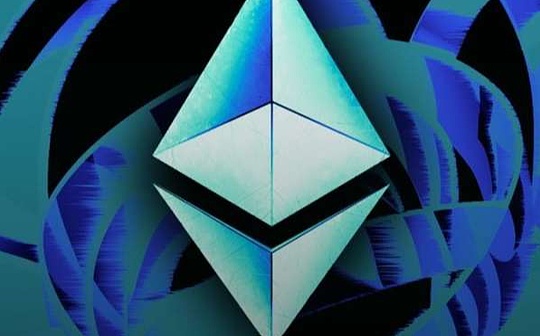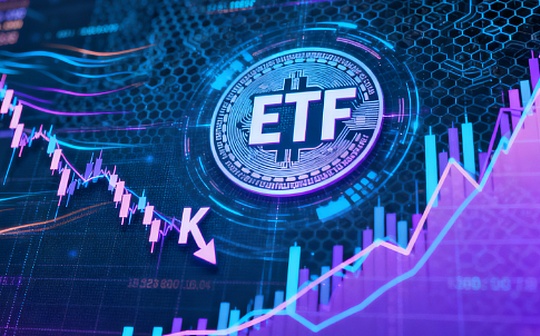
Author: Kevin Li Source: Artemis Translation: Shan Oppa, Bitchain Vision
Dear fundamental investors, we have delved into Strategy, CoreWeave, Coinbase, Circle and Hyperliquid.
Recently, Ethereum has received renewed attention, especially after the rise of the narrative “ETH as a corporate fiscal reserve”.One of our fundamental analysts constructed an ETH valuation framework and presented a persuasive long-term bull market perspective.Welcome to contact us and exchange ideas at any time – of course, don’t forget to do your own research.
Next, please see analyst Kevin Li’s in-depth analysis of ETH.
Executive Summary:
-
Ethereum (ETH) is transforming from a misunderstood asset to aScarce, programmable reserve assets, providing a security guarantee and operation foundation for the rapid advancement of an institutionalized on-chain ecosystem.
-
ETH’s adaptive monetary policyInflation is expected to continue to decline – even if the entire network is 100% pledged, the annual inflation rate will cap off at about 1.52%; by year 100 (2125), this proportion will drop to about 0.89%.This is not only significantly lower than the average annual expansion rate of the US M2 money supply of 6.36% between 1998 and 2024, but it is even comparable to the growth of gold supply.
-
The mechanism is accelerating, giants including JPMorgan Chase and BlackRock all deploy their businesses on Ethereum, which continues to drive structural demand for ETH for on-chain security and value settlement.
-
Annual correlation of up to 88% between on-chain asset growth and native ETH staking, highlighting strong economic alignment.
-
May 29, 2025 SEC clarification on pledge policy, reducing regulatory uncertainty.The latest Ethereum ETF application has been added to the pledge terms, further enhancing the earnings potential and institutional appeal.
-
High composability of ETHMake it a productive asset: it is used for pledge and re-staking, as DeFi collateral (such as Aave, Maker), automatic market makers (AMM) liquidity (such as Uniswap), and is also a native gas token for many Layer 2 networks.
-
Although Solana has attracted a lot of attention during the meme coin boom, Ethereum is strongerDecentralization and security, making it more dominant in the higher value, long-term sustainable asset issuance market.
-
With Sharplink Gaming ($SBET) first launching the Ethereum Treasury allocation in May 2025, the ETH fiscal reserve narrative has emerged, and now it has exceeded730,000 ETHs are held by listed companies.This demand path replicates the wave of Bitcoin’s fiscal reserves in 2020, and promotes ETH’s recent strong performance compared to BTC.
Not long ago, Bitcoin’s positioning as a “store of value” was still questioned, and the argument of “digital gold” sounds ridiculous to many people.And today, Ethereum (ETH) is facing a similar identity crisis.It is often misunderstood, underperforming many altcoins in annualized returns, missing multiple meme cycles, and also encountering bottlenecks in the overall retail adoption rate of the crypto ecosystem.
People often criticize ETHLack of clear value accumulation mechanism, believes that the rise of Layer 2 has eroded the underlying expense income, thereby weakening ETH’s position as a monetary asset.When ETH is singlely regarded as a representative of “transaction fees,” “protocol revenue,” or “real economic value,” it looks more like a cloud-computing stock—more closer to Amazon stock than a sovereign digital currency.
But in my opinion, this understanding is about asset typesClassification error.Measuring ETH from the perspective of cash flow or protocol revenue alone is confusing completely different asset classes.The correct way is to understand it in the framework of “commodity-like assets” and be closer to the positioning of Bitcoin.More precisely, ETH is a unique asset class:Scarce, production, programmable reserve assets, its value accumulation comes from itsProvide security, settlement and computing capabilities in the on-chain economyThe core role of this chain economy is rapidly moving towards institutionalization and combination.
Why does the world need new choices in the era of depreciation of fiat currency
To truly understand the evolution of ETH currency attributes, it must be examined in a more macroeconomic environment—especially at presentFiat currency depreciation and currency expansionAn era of intensification.Driven by ongoing government stimulus and spending, the official inflation rate is often underestimated.While CPI data usually show annual inflation is around 2%, this indicator is often modified, which may mask the real loss of actual purchasing power.
From 1998 to 2024, the average annual inflation of the US CPI was2.53%,andM2 money supply expands at an average annual rate of 6.36%.——This is not only far beyond inflation and housing prices rising speed, but it is even close to S&P 500’s annual average return (8.18%).This also means that most of the nominal growth of US stocks may be more of the result of monetary expansion than productivity gains.
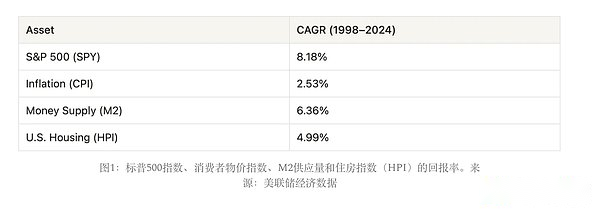
This surge in money supply reflects that when the government faces economic instability,Monetary stimulus and fiscal expenditureThe dependence of the company is growing.For example, the Big Beautiful Bill (BBB) introduced by the Trump administration is a radical fiscal stimulus policy that is widely regarded as inflation-oriented; while the implementation effect of the “DOGE” policy advocated by Musk is far lower than expected.
All of the above have aggravated the market’s concerns about the failure of the traditional monetary system and further accelerated people’s concern forA new generation of store of value tools or currency formsurgent need.
What constitutes a “storage means of value”?Where is ETH?
A reliable storage of value usually requires four criteria:
-
Durability: Able to withstand the test of time without corrosion or deterioration.
-
Value preservation ability: Can maintain purchasing power in different market cycles.
-
Liquidity: Must be able to trade easily in an active market.
-
Adoption and trust: Must be widely trusted or adopted.
At present, ETH isDurabilityandLiquidityExcellent performance in terms of.Its durability comes from the decentralization and security of the Ethereum network; while liquidity is very high – ETH is the second largest crypto asset in the world with trading volume, and has a deep market in both centralized and decentralized exchanges.
However, if evaluated from the perspective of “value storage means” in the traditional sense, ETH is still controversial in terms of “value preservation ability”, “adoption degree” and “trust degree”.This is also where the concept of “scarce programmable reserve assets” is more in line with ETH’s positioning – it emphasizes the active role and unique mechanism of ETH in value maintenance and trust establishment.
ETH’s monetary policy: scarce but adaptable
One of the most controversial questions about whether ETH can become a means of store of value is itsMonetary Policy, especially its design in terms of supply and inflation.Critics often point out that Ethereum does not have a fixed maximum supply cap.However, this criticism ignores EthereumDynamic release modelThe architectural complexity and subtlety.
The issuance of ETH is dynamically related to the amount of pledged ETH.Although the higher the pledge participation, the increase in issuance volume, this relationship isSublinear: That is,The inflation rate is rising slowly than the pledge volume is growing.This is because the issuance volume is inversely proportional to the square root of the total pledge, thus forming a natural relief mechanism for inflation.
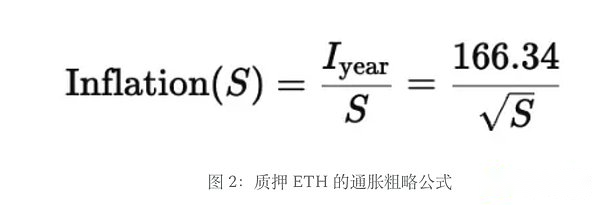
This mechanism has established aA gradually falling soft inflation cap, Even if the pledge participation rate continues to rise, inflation will tend to slow down.In the most extreme situation set by the model (i.e., 100% ETH is pledged), the annual inflation rate isThe upper limit is set to approximately 1.52%.
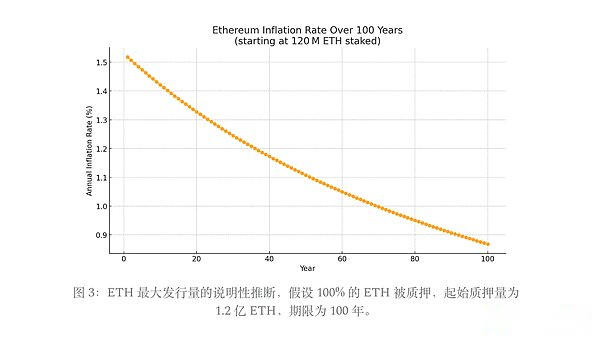
More importantly, even under this most conservative premise, inflation continues to decline over time—following aExponential decay curve.Assuming that 100% pledge and no destruction mechanism, the inflation rate trend is as follows:
-
Year 1 (2025): Approximately 1.52%
-
Year 20 (2045): Approximately 1.33%
-
Year 50 (2075): Approximately 1.13%
-
Year 100 (2125): Approximately 0.89%
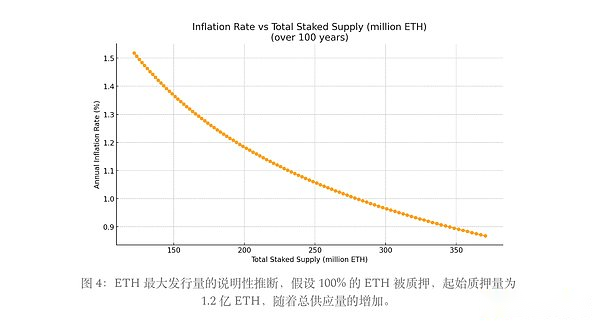
Even in such a conservative situation, Ethereum’s inflation rate is still on the downward trend, reflecting aBuilt-in monetary discipline, enhances its credibility as a means of long-term value storage.
And ifDestruction mechanism introduced by EIP-1559Considering this, the situation will improve further.This mechanism will permanently remove part of the transaction fee from circulation, which means ETH’sNet inflation can be much lower than the total issuance rate, in some periods, it even turns toNegative value (i.e. deflation).In fact, since Ethereum switched from Proof of Work (PoW) to Proof of Stake (PoS),The net inflation rate of ETH is always lower than the issuance rate and there is a deflation phase from time to time.
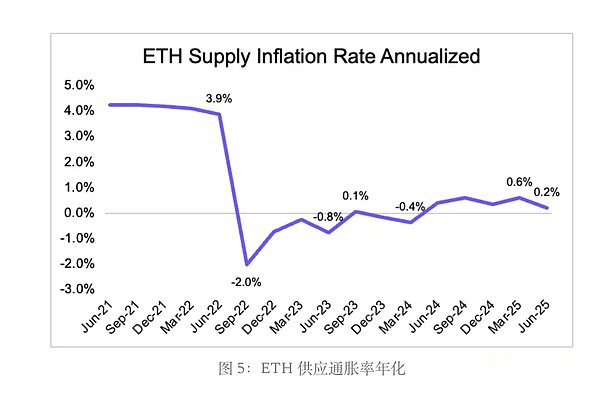
Compared with fiat currencies such as the US dollar, its M2 money supply has an average annual growth of more than 6% – EthereumStructurally restricted (or even potential deflation) supply mechanismsMake it more attractive as a value asset.It is worth noting that Ethereum’s largest supply growth is nowAlign with or even below gold, further consolidates its position as a reliable monetary asset.
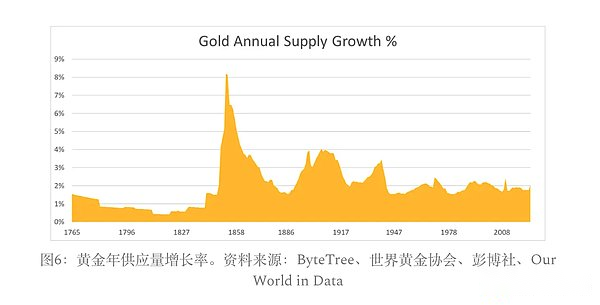
Institutional adoption and trust
Although Ethereum’s monetary mechanism effectively solves the problem of supply dynamics, its practical utility as a settlement layer is now a core factor in promoting adoption and winning institutional trust.Major financial institutions are building applications directly on top of Ethereum: Robinhood is developing a tokenized stock platform, JPMorgan Chase is planning to launch its deposit token JPMD on the Ethereum layer 2 network Base, and BlackRock is leveraging BUIDL tokenized money market funds on the Ethereum network.
This on-chain trend stems from a strong value proposition that can solve inefficiency problems in traditional finance and unlock new opportunities:
-
Efficiency and cost reduction: Traditional finance relies on intermediaries, manual processes and slow settlement mechanisms.Blockchain simplifies processes through automation and smart contracts, thereby significantly reducing costs, reducing errors, and reducing processing time from days to seconds.
-
Liquidity and Shared Ownership: Asset tokenization allows illicit assets such as real estate and art to be leveraged, broadens investors’ participation channels, and releases locked capital.
-
Transparency and compliance: Blockchain’s tamper-free ledger ensures a verifiable audit trajectory, simplifying compliance processes and reducing fraud risks through real-time transactions and visibility of asset ownership.
-
Innovation and Market Access: Composable on-chain assets have promoted the birth of new financial products, such as automated lending or synthetic assets, creating new channels of income and expanding the coverage of financial services.
ETH staking: Alignment of security and economic interests
The on-chain migration of traditional financial assets highlights two core drivers of ETH demand.First, the growth of real-world assets (RWA) and stablecoins has increased on-chain activity, thus driving the use of ETH as a gas token.More importantly, as Tom Lee pointed out, institutions may need to purchase and stake ETH to secure the infrastructure they rely on, thus achieving the benefits of long-term security with Ethereum.In this context, stablecoins can be regarded as Ethereum’s “ChatGPT moment” – a major breakthrough application scenario that demonstrates the platform’s transformational potential and wide uses.
As more and more value settles on the chain, the alignment between Ethereum’s security and economic value becomes increasingly important.Its termination mechanism, Casper FFG, ensures that blocks are finally confirmed only when at least two-thirds of the staked ETH reach a consensus.Although attackers cannot complete the end of malicious blocks if they control at least one-third of the staked ETH, they can prevent finalization by breaking consensus mechanisms.In this case, Ethereum can still propose and process blocks, but the lack of finality means that these transactions may be reversed or reordered, which poses a significant risk to institutional settlement use cases.
Even applications running on Layer 2 rely on the Ethereum main chain for final settlement.Layer 2 not only did not weaken the value of ETH, but instead strengthened the status of ETH through the demand for main layer security and gas.They submit proof to Ethereum, pay the underlying fee, and often use ETH as the native gas token.As the execution scale of rollup expands, Ethereum’s role as a secure settlement layer also accumulates value simultaneously.
In the long run, many institutions may gradually shift from managed passive staking to running their own verification nodes.Although third-party staking solutions are more convenient, operational verification nodes can bring more control, higher security to institutions and directly participate in the consensus process.This is especially important for stablecoins and RWA issuers, as they can capture MEVs, ensure reliable inclusion of transactions and leverage private execution capabilities—all key abilities to ensure operational stability and transaction integrity.
More importantly, institutions’ wider participation in verification node operations will help alleviate the problem of excessive concentration of Ethereum’s current staking, which is currently mainly concentrated on a few large participants, such as mobile staking protocols and centralized exchanges.Institutional participation helps to diversify nodes, enhance Ethereum’s decentralization level, improves its censorship resistance and credibility of the global settlement network.
From 2020 to 2025, a persuasive trend further strengthens the logic of consistency of interests: the growth of on-chain assets is highly synchronized with the growth of ETH staking.As of June 2025, the total supply of stablecoins on Ethereum reached US$116.06 billion, and the tokenization of real-world assets (RWA) rose to US$6.89 billion.At the same time, the total amount of pledged ETH increased to 35.53 million, significantly reflecting the value of network participants on the extended chain while simultaneously enhancing security.
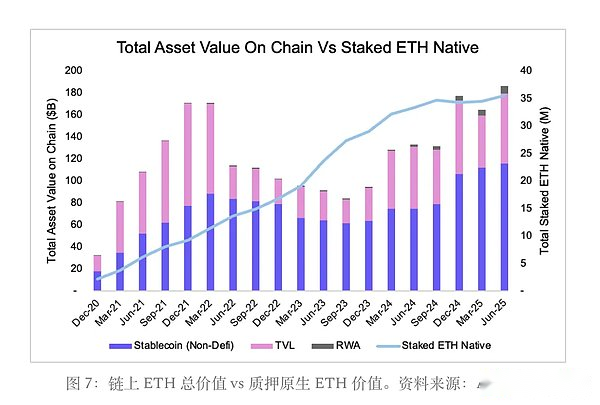
Among the major asset classes, the annual correlation between on-chain asset growth and native ETH staking remains above 88%.In particular, there is a close relationship between the supply of stablecoin and ETH staking.Although quarterly correlations are greatly affected by short-term volatility, the long-term trend is clear – as assets migrate on the chain, the motivation to pledge ETH also increases.
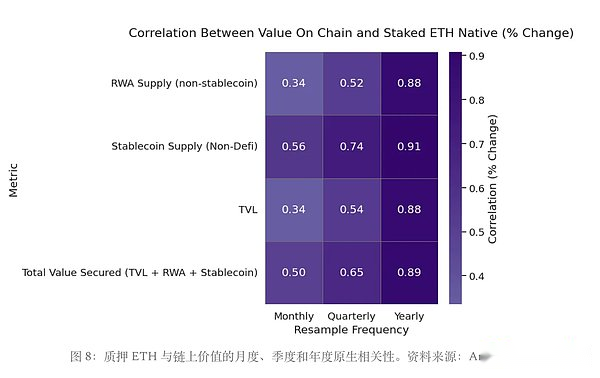
In addition, staking growth also directly affects the price dynamics of ETH.As more ETH is pledged and exited the circulation market, the circulation supply of ETH is tightening in the cycle of on-chain demand.Our analysis shows that the correlation between ETH pledge volume and price on an annual scale is 90.9% and 49.6% on a quarterly scale.This further supports the view that pledge not only guarantees network security, but also creates positive supply and demand pressure on ETH prices in the long run.
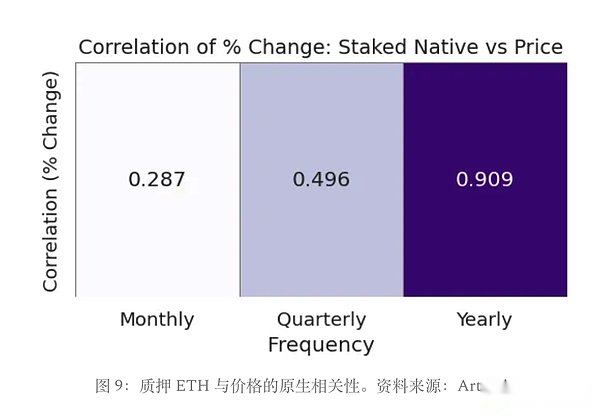
On May 29, 2025, the latest policy clarification released by the Securities and Exchange Commission (SEC) Corporate Finance Department eased regulatory uncertainty around Ethereum staking.The statement pointed out that under specific conditions, agreement-level pledge activities (such as self-pled, entrusted pledge or custodial pledge that meets the conditions) do not constitute securities issuance.Although more complex pledge arrangements still require individual judgment, this clarification has encouraged institutions to participate more actively.
After the announcement, the submitted Ethereum ETF application began to include pledge terms, allowing funds to earn rewards while participating in cybersecurity.This not only improves the return structure, but also further consolidates the trust basis of Ethereum as a long-term institutional adoption platform.
Composability and ETH as a productive asset
One of the key differences between ETH and pure store of value assets like gold and Bitcoin is its composability, and this feature itself can drive the demand for ETH.Compared with non-productive assets gold and BTC, ETH is natively programmable and plays an active role in the Ethereum ecosystem, powering decentralized finance (DeFi), stablecoins, and Layer 2 networks.
CompositionalityRefers to the ability to seamlessly interoperate between protocols and assets.In Ethereum, this makes ETH more than just a monetary asset, but also an important building block for on-chain applications.As more and more protocols are built around, or built directly on, ETH, the demand for ETH increases with it—not just as gas, but also as collateral, liquidity sources and pledged capital.
Currently, ETH is widely used in the following key scenarios:
-
Pledge and re-pled: ETH is used to ensure the security of the Ethereum main network, and can also be restaked through EigenLayer to provide security support for oracles, Rollup and middleware.
-
Lending and stablecoin collateral: ETH supports major lending agreements such as Aave and Maker, and is also the underlying asset of over-collateralized stablecoins.
-
Mobility in AMM: In DEXs such as Uniswap and Curve, ETH trading pairs dominate, supporting efficient redemption throughout the ecosystem.
-
Cross-chain Gas:ETH is a native gas token that includes most Layer 2 such as Optimism, Arbitrum, Base, zkSync, Scroll, etc.
-
Cross-chain interoperability: ETH can be bridged, packaged and used in non-EVM chains (such as Solana, Cosmos (via Axelar), etc.), becoming one of the most liquid assets on the chain.
The diverse uses of deep integration of ETH make it a scarce but productive reserve asset.As ETH becomes more embedded in the entire ecosystem, conversion costs increase, and network effects also increase.In a sense, ETH is more like gold than Bitcoin.A large part of the value of gold comes from its industrial and jewelry uses, not just investment attributes; while Bitcoin lacks similar functional practical scenarios.
Ethereum vs. Solana: Layer 1 Route Diversification
During this cycle, Solana became the biggest winner in the Layer 1 track.It successfully carries the memecoin ecosystem and becomes an active network for the launch of new tokens and gaining attention.Although this momentum is real, Solana’s decentralization is still far lower than Ethereum due to the limited number of verification nodes and the high threshold for participating in hardware.
That being said, future demand for Layer 1 block space may be hierarchical.In this hierarchical structure, Solana and Ethereum can coexist.Different types of assets have different trade-offs on speed, efficiency, and security.However, in the long run, Ethereum is more likely to carry higher value assets due to its stronger decentralization and security assurance; while Solana may be suitable for handling frequent small transactions.
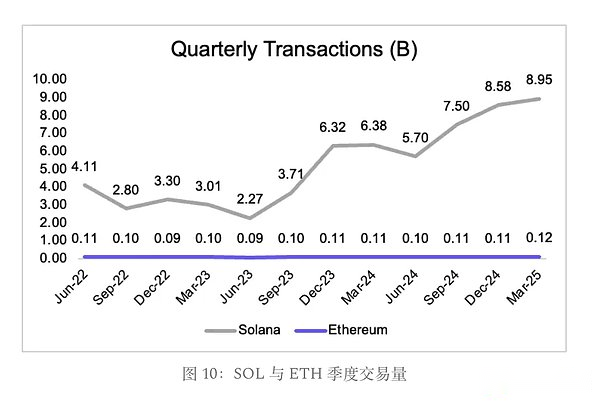
It should be noted that in the financial market,The demand for high security assets is much higher than that for assets that only pursue execution speed.This structural preference is beneficial to Ethereum: as more and more high-value assets are put on the chain, the value of Ethereum as the basic settlement layer will continue to increase.
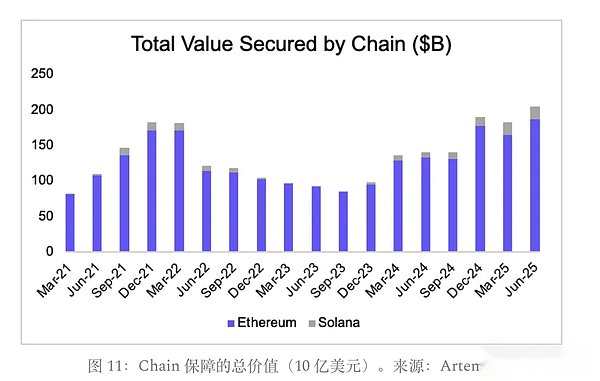
Ethereum’s “MicroStrategy Moment”: Treasury Trends Boost ETH
In addition to the two long-term structural drivers of on-chain assets and institutional demand, the rise of Ethereum’s treasury strategy—similar to MicroStrategy’s use of bitcoin as a company’s asset—can also be a medium-term driver of ETH.The key turning point came at the end of May, when Sharplink Gaming (stock code $SBET) announced its Ethereum Treasury strategy, led by Ethereum co-founder Joseph Lubin.

This type of treasury strategy not only helps tokens acquire traditional financial (TradFi) liquidity, but also increases the asset value per share of participating companies.Since the rise of ETH’s Treasury strategy, these Treasury companies have held over 730,000 ETHs in total, and ETH has begun to outperform BTC in this cycle – an extremely rare historically.We believe that this marks the beginning of the trend of adopting Ethereum treasury strategy.
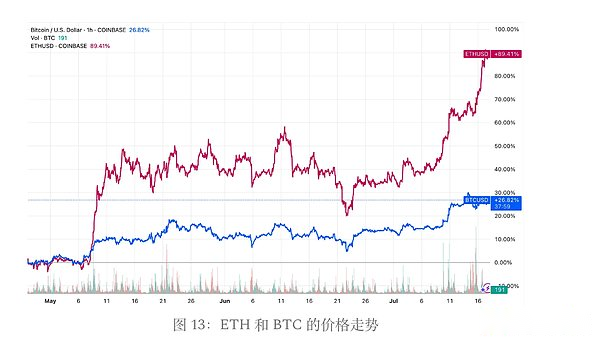
Conclusion: ETH is a reserve asset for on-chain economy
The development of Ethereum represents a fundamental reshaping of the concept of monetary assets in the digital economy.Just as Bitcoin overcomes doubts in its early years and ultimately wins the title of “digital gold”, ETH is also establishing its own unique identity—not through imitating BTC’s narrative, but through growing into a more versatile and fundamental asset.
ETH is not just a cloud-like service voucher, but also a practical token or protocol revenue source for paying transaction fees.It is a scarce, programmable, economically vital reserve asset that supports the increasingly institutionalized on-chain financial system.Security, settlement and functionality.

